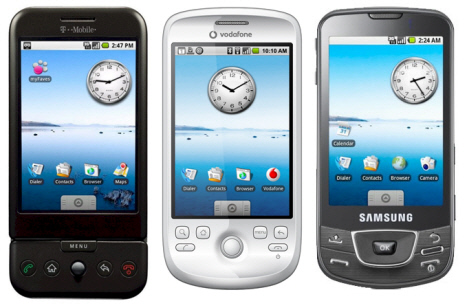2nd generation Android phones battle it out with iPhone

By the end of this summer, users will have three Android powered cell phone models to chose from instead of just one. Joining the venerable HTC Dream (aka the T-Mobile G1) will be the HTC Magic (May) and the Samsung I7500 (June).

The new phones, running Android 1.5 (Cupcake edition) will be competing head to head with the Apple iPhone, running the iPhone OS 3.0. Assuming you're lucky enough to live in an place where these phones are actually available, how do you decide which one to get? In this article I'll briefly compare them in areas such as their displays, keyboards (or lack thereof), and applications.
Continue reading: Display and Buttons >
Display
All the phones feature a 320x480 pixel resolution capacitance touch screen designed for fingers, not styluses (stylii?). The iPhone's display measures 3.5" diagonally, while the Android phones all opted for the slightly smaller 3.2" diagonal screen. A smaller screen will fit better in your pocket, but the correspondingly smaller text and graphics can sometimes be a disadvantage for those without perfect vision.
The Samsung I7500 breaks with the pack by going with an OLED (organic light emitting diode) technology for its display. OLED displays do not require backlighting because each pixel gives off its own light, so they draw less battery power. They're also thinner. However they're more expensive to make than conventional displays so the phone might be a little pricier.
Buttons
The iPhone is famous for only having one button, which simply takes you to the home screen. Ok, two buttons if you count the power button on top. All the Android phones have the home button plus 2 buttons for answering and hanging up the telephone, one for opening the Menu, and another one for going Back to the previous application window. The two HTC models sport a Blackberry-like trackball, while Samsung went with a more conventional D-pad arrangement (up, down, left, right, and OK/Select).
I play a lot of games on my phones, and I must say that having real buttons is very handy for certain types of games like platform shooters. However, the recessed buttons and tiny trackball on the G1 were unsuited to this use. It looks like the Magic, with its rounded buttons and over sized trackball, was designed with games in mind.
Continue reading: Keyboard, Applications, and Connectors >
Keyboard
The HTC Dream (G1) is the only one of this group to feature a physical keyboard. Whether or not you need a keyboard is a personal preference. Some people will be quite happy banging out tweets on their iPhone or Android Cupcake on-screen virtual keyboard, while others won't touch a non-QWERTY device. Having a keyboard adds to the bulk and "creakiness" of the G1, so I won't be sad to see it go.
Applications
One of the big complains about the G1 is its extremely limited internal flash memory for storing applications. On a factory fresh phone, you only have about 78MB free. Contrast this to an iPhone which has at least 7GB free for downloaded programs and media. The Magic helps a little with this problem by doubling the internal storage from 256MB to 512MB, which quadruples the free space for programs. Although details are sketchy, Samsung reportedly goes far beyond that on the I7500 with 8GB of internal storage. That's in addition to the removable MicroSD cards that all these Android phones support.
Connectors
HTC has opted to continue their unpopular decision to use a non-standard connector for USB and headphones on the Magic. Apple's dock connector is technically non-standard, but it has become a de-facto standard with support from dozens of third-party manufacturers. Both the Apple and Samsung phones provide a standard 3.5mm stereo jack for headphones.
Continue reading: Conclusion >
Conclusion
Unfortunately your geography and carrier are going to play a bigger role than anything else in your selection of a new phone. After that, if you've absolutely got to have a physical keyboard then the G1/Dream is your only choice for a while, unless you want to jump ship to a Blackberry or (shudder) Windows Mobile device.
If you need a long battery life and tons of room for applications, the I7500 or iPhone might be your best bet. Right now the iPhone has far and away the best selection of entertainment and productivity apps, but due to Android's open source architecture the 'droids are catching up fast.
If you liked the G1 but you were put off by its size and heft then the HTC Magic has your name on it. The Magic is the natural successor to the G1: it's smaller, thinner, and sexier. Hopefully the battery will last longer and the screen will be more visible in bright light.
So which is the perfect phone? As is often the case, none of the above. If I could design the perfect phone I'd probably start with the iPhone's mechanical design and CPU, load it with the Android operating system, add a few game-friendly buttons, and finally use a multi-band radio that would run (unlocked) with any carrier's network, Wi-Fi (802.11n), and Bluetooth 3.0.